fuel SKODA FABIA 2008 2.G / 5J Service Manual
[x] Cancel search | Manufacturer: SKODA, Model Year: 2008, Model line: FABIA, Model: SKODA FABIA 2008 2.G / 5JPages: 252, PDF Size: 40.88 MB
Page 210 of 252
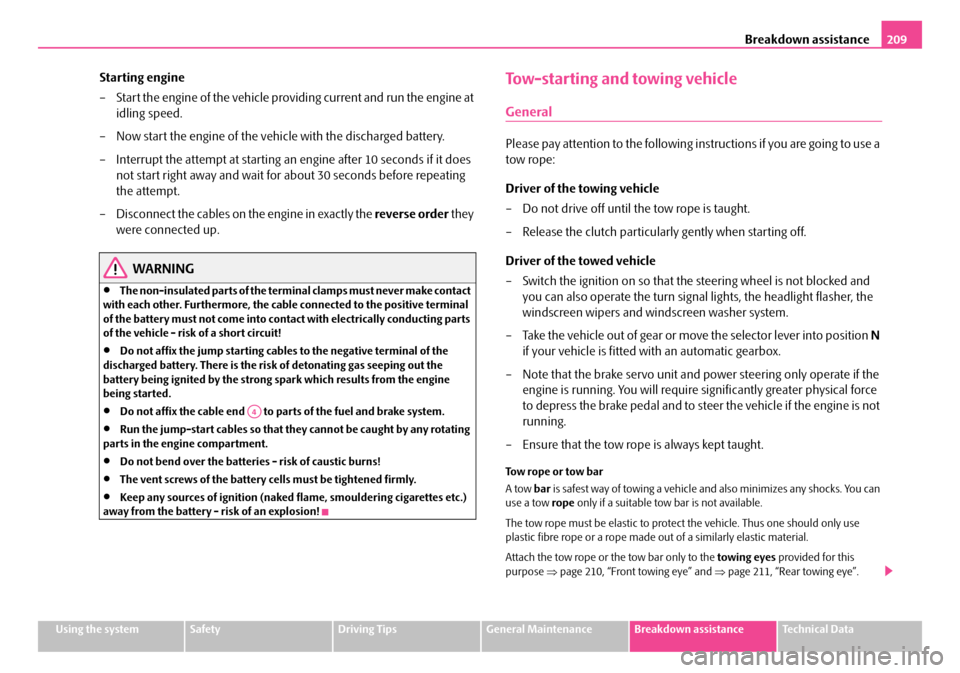
Breakdown assistance209
Using the systemSafetyDriving TipsGeneral MaintenanceBreakdown assistanceTechnical Data
Starting engine
– Start the engine of the vehicle providing current and run the engine at
idling speed.
– Now start the engine of the vehicle with the discharged battery.
– Interrupt the attempt at starting an engine after 10 seconds if it does
not start right away and wait for about 30 seconds before repeating
the attempt.
– Disconnect the cables on the engine in exactly the reverse order they
were connected up.
WARNING
•The non-insulated parts of the terminal clamps must never make contact with each other. Furthermore, the cable connected to the positive terminal of the battery must not come into contact with electrically conducting parts of the vehicle - risk of a short circuit!
•Do not affix the jump starting cables to the negative terminal of the discharged battery. There is the risk of detonating gas seeping out the battery being ignited by the strong spark which results from the engine being started.
•Do not affix the cable end to parts of the fuel and brake system.
•Run the jump-start cables so that they cannot be caught by any rotating parts in the engine compartment.
•Do not bend over the batteries - risk of caustic burns!
•The vent screws of the battery cells must be tightened firmly.
•Keep any sources of ignition (naked flame, smouldering cigarettes etc.) away from the battery - risk of an explosion!
Tow-starting and towing vehicle
General
Please pay attention to the following instructions if you are going to use a
tow rope:
Driver of the towing vehicle
– Do not drive off until the tow rope is taught.
– Release the clutch particularly gently when starting off.
Driver of the towed vehicle
– Switch the ignition on so that the steering wheel is not blocked and
you can also operate the turn signal lights, the headlight flasher, the
windscreen wipers and windscreen washer system.
– Take the vehicle out of gear or move the selector lever into position N
if your vehicle is fitted with an automatic gearbox.
– Note that the brake servo unit and power steering only operate if the
engine is running. You will require significantly greater physical force
to depress the brake pedal and to steer the vehicle if the engine is not
running.
– Ensure that the tow rope is always kept taught.
Tow rope or tow bar
A tow bar is safest way of towing a vehicle and also minimizes any shocks. You can use a tow rope only if a suitable tow bar is not available.
The tow rope must be elastic to protect the vehicle. Thus one should only use plastic fibre rope or a rope made out of a similarly elastic material.
Attach the tow rope or the tow bar only to the towing eyes provided for this purpose ⇒page 210, “Front towing eye” and ⇒page 211, “Rear towing eye”.
A4
NKO A05F 20.book Page 209 Wednesday, April 2, 2008 1:02 PM
Page 212 of 252

Breakdown assistance211
Using the systemSafetyDriving TipsGeneral MaintenanceBreakdown assistanceTechnical Data
Rear towing eye
The rear towing eye is located below the rear bumper on the right ⇒fig. 191.
Tow-starting a vehicle
If the engine does not start, we generally do not recommend to tow-start
your vehicle. One should attempt to start the engine using jump start
cables ⇒page 208 or call on the services of the SERVICE mobile.
If your vehicle has to be towed:
– Engage 2nd or 3rd gear with the vehicle stationary.
– Depress the clutch pedal fully and keep it depressed.
– Switch on the ignition.
– Wait until both vehicles are moving then release the clutch pedal
slowly.
– Depress the clutch pedal fully when the engine fires and take the
vehicle out of gear.
WARNING
There is high risk of having an accident when tow-starting a vehicle, when for example the towed vehicle runs into the towing vehicle.
Caution
Vehicles which are fitted with a catalytic converter should not be tow-started over a distance of more than 50 metres. Unburnt fuel may get into the catalytic converter and damage it.
Towing in a vehicle fitted with a manual gearbox
Please refer to the notes ⇒page 209.
The car can be towed in with a tow bar or a tow rope or with the front or rear wheels raised. The maximum towing speed is 50 km/h.
Towing of a vehicle with an automatic gearbox
Please refer to the notes ⇒page 209.
The car can be towed in with a tow bar or a tow rope. Refer at the same time to the following guidelines:
•Move selector lever into N.
•The maximum towing speed is 50 km/h.
•The maximum permissible towing distance is 50 km. The gear oil pump does not operate when the engine is not running; the gearbox would not be adequately lubricated at higher speeds and over longer towing distance.
Caution
If the vehicle is towed in by a recovery vehicle, it should only be towed in with the front wheels raised. If the vehicle is raised at rear, the automatic gearbox is damaged!
Fig. 191 Rear towing eye
NKO A05F 20.book Page 211 Wednesday, April 2, 2008 1:02 PM
Page 216 of 252
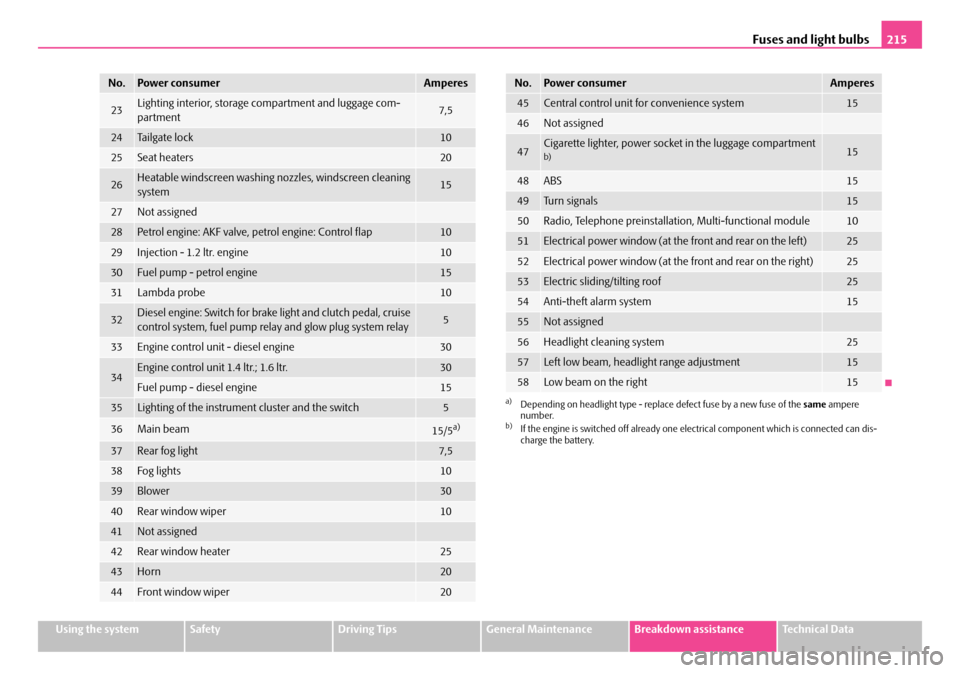
Fuses and light bulbs215
Using the systemSafetyDriving TipsGeneral MaintenanceBreakdown assistanceTechnical Data
23Lighting interior, storage compartment and luggage com-partment7,5
24Tailgate lock10
25Seat heaters20
26Heatable windscreen washing nozzles, windscreen cleaning system15
27Not assigned
28Petrol engine: AKF valve, petrol engine: Control flap10
29Injection - 1.2 ltr. engine10
30Fuel pump - petrol engine15
31Lambda probe10
32Diesel engine: Switch for brake light and clutch pedal, cruise control system, fuel pump relay and glow plug system relay5
33Engine control unit - diesel engine30
34Engine control unit 1.4 ltr.; 1.6 ltr.30
Fuel pump - diesel engine15
35Lighting of the instrument cluster and the switch5
36Main beam15/5a)
37Rear fog light7,5
38Fog lights10
39Blower30
40Rear window wiper10
41Not assigned
42Rear window heater25
43Horn20
44Front window wiper20
No.Power consumerAmperes
45Central control unit for convenience system15
46Not assigned
47Cigarette lighter, power socket in the luggage compartment b)15
48ABS15
49Turn signals15
50Radio, Telephone preinstallation, Multi-functional module10
51Electrical power window (at the front and rear on the left)25
52Electrical power window (at the front and rear on the right)25
53Electric sliding/tilting roof25
54Anti-theft alarm system15
55Not assigned
56Headlight cleaning system25
57Left low beam, headlight range adjustment15
58Low beam on the right15
a)Depending on headlight type - replace defect fuse by a new fuse of the same ampere number.b)If the engine is switched off already one electrical component which is connected can dis-charge the battery.
No.Power consumerAmperes
NKO A05F 20.book Page 215 Wednesday, April 2, 2008 1:02 PM
Page 224 of 252
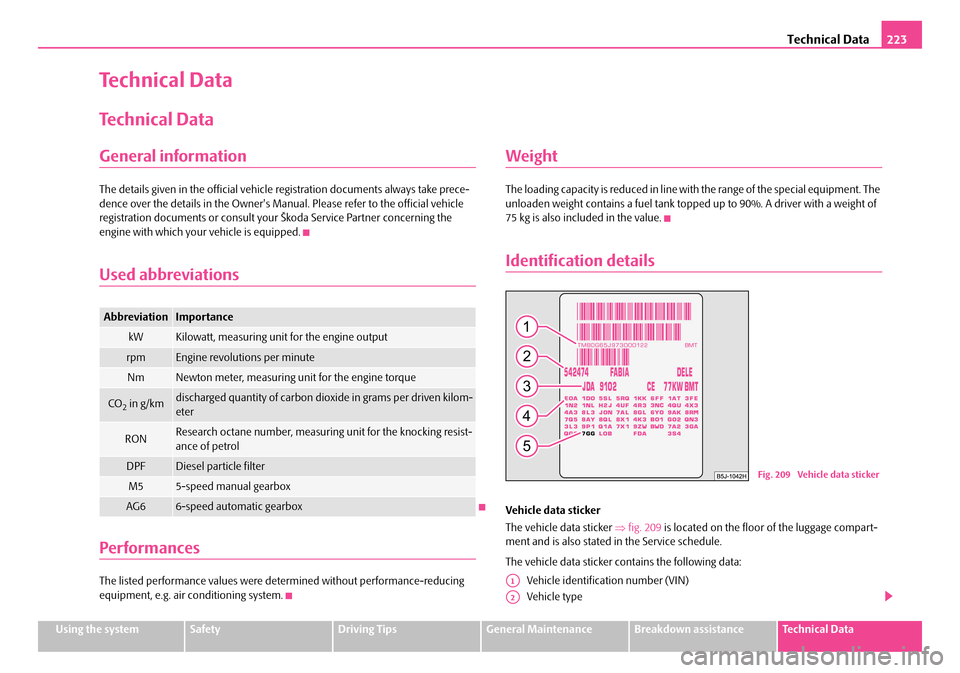
Technical Data223
Using the systemSafetyDriving TipsGeneral MaintenanceBreakdown assistanceTechnical Data
Technical Data
Technical Data
General information
The details given in the official vehicle registration documents always take prece-dence over the details in the Owner's Manual. Please refer to the official vehicle registration documents or consult your Škoda Service Partner concerning the engine with which your vehicle is equipped.
Used abbreviations
Performances
The listed performance values were determined without performance-reducing equipment, e.g. air conditioning system.
Weight
The loading capacity is reduced in line with the range of the special equipment. The unloaden weight contains a fuel tank topped up to 90%. A driver with a weight of 75 kg is also included in the value.
Identification details
Vehicle data sticker
The vehicle data sticker ⇒fig. 209 is located on the floor of the luggage compart-ment and is also stated in the Service schedule.
The vehicle data sticker contains the following data:
Vehicle identification number (VIN)
Vehicle type
AbbreviationImportance
kWKilowatt, measuring unit for the engine output
rpmEngine revolutions per minute
NmNewton meter, measuring unit for the engine torque
CO2 in g/kmdischarged quantity of carbon dioxide in grams per driven kilom-eter
RONResearch octane number, measuring unit for the knocking resist-ance of petrol
DPFDiesel particle filter
M55-speed manual gearbox
AG66-speed automatic gearbox
Fig. 209 Vehicle data sticker
A1
A2
NKO A05F 20.book Page 223 Wednesday, April 2, 2008 1:02 PM
Page 225 of 252
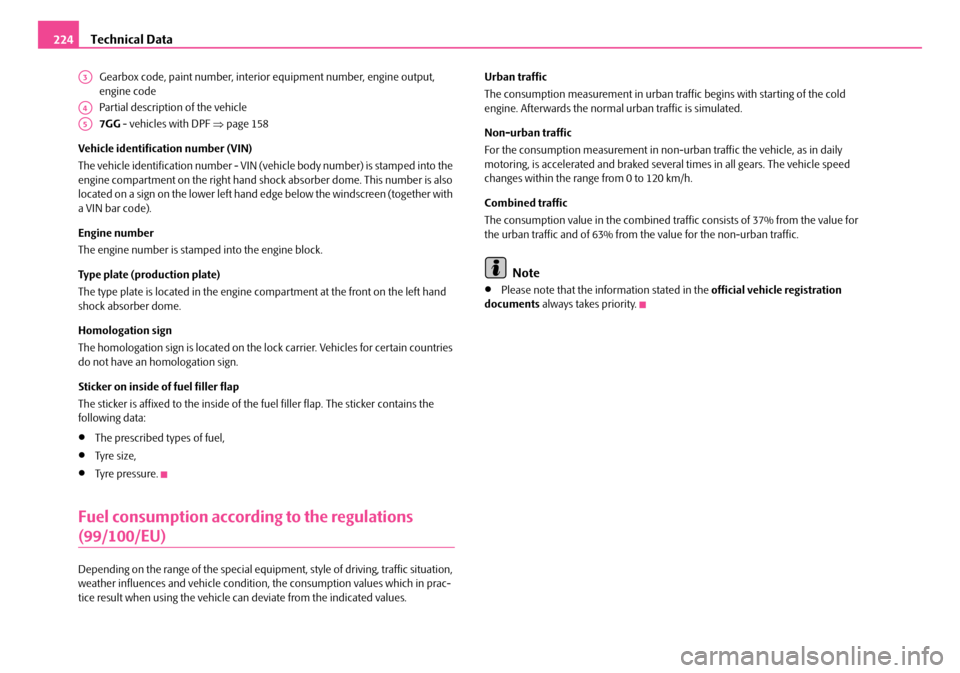
Technical Data224
Gearbox code, paint number, interior equipment number, engine output, engine code
Partial description of the vehicle
7GG - vehicles with DPF ⇒page 158
Vehicle identification number (VIN)
The vehicle identification number - VIN (vehicle body number) is stamped into the engine compartment on the right hand shock absorber dome. This number is also located on a sign on the lower left hand edge below the windscreen (together with a VIN bar code).
Engine number
The engine number is stamped into the engine block.
Type plate (production plate)
The type plate is located in the engine compartment at the front on the left hand shock absorber dome.
Homologation sign
The homologation sign is located on the lock carrier. Vehicles for certain countries do not have an homologation sign.
Sticker on inside of fuel filler flap
The sticker is affixed to the inside of the fuel filler flap. The sticker contains the following data:
•The prescribed types of fuel,
•Tyre si z e,
•Tyre pressure.
Fuel consumption according to the regulations
(99/100/EU)
Depending on the range of the special equipment, style of driving, traffic situation, weather influences and vehicle condition, the consumption values which in prac-tice result when using the vehicle can deviate from the indicated values.
Urban traffic
The consumption measurement in urban traffic begins with starting of the cold engine. Afterwards the normal urban traffic is simulated.
Non-urban traffic
For the consumption measurement in non-urban traffic the vehicle, as in daily motoring, is accelerated and braked several times in all gears. The vehicle speed changes within the range from 0 to 120 km/h.
Combined traffic
The consumption value in the combined traffic consists of 37% from the value for the urban traffic and of 63% from the value for the non-urban traffic.
Note
•Please note that the information stated in the official vehicle registration documents always takes priority.
A3
A4
A5
NKO A05F 20.book Page 224 Wednesday, April 2, 2008 1:02 PM
Page 227 of 252

Technical Data226
1.2 l/44 kW - EU 4/EU 2DDK
Engine
Performances
Fuel consumption (in ltr./100 km) and CO2 emission (in g/km)
Power outputkW per rpm44/5200
Maximum torqueNm per rpm108/3000
Number of cylinders/Displacement (cm3)3/1198
Fuel - unleaded petrol min. RON95
FA B I ACO M B I
Maximum speedkm/h155156
Acceleration 0 - 100 km/hs16,516,8
Urban7,8
Non-urban4,8
Combination5,9
CO2 emission - combination140
NKO A05F 20.book Page 226 Wednesday, April 2, 2008 1:02 PM
Page 228 of 252
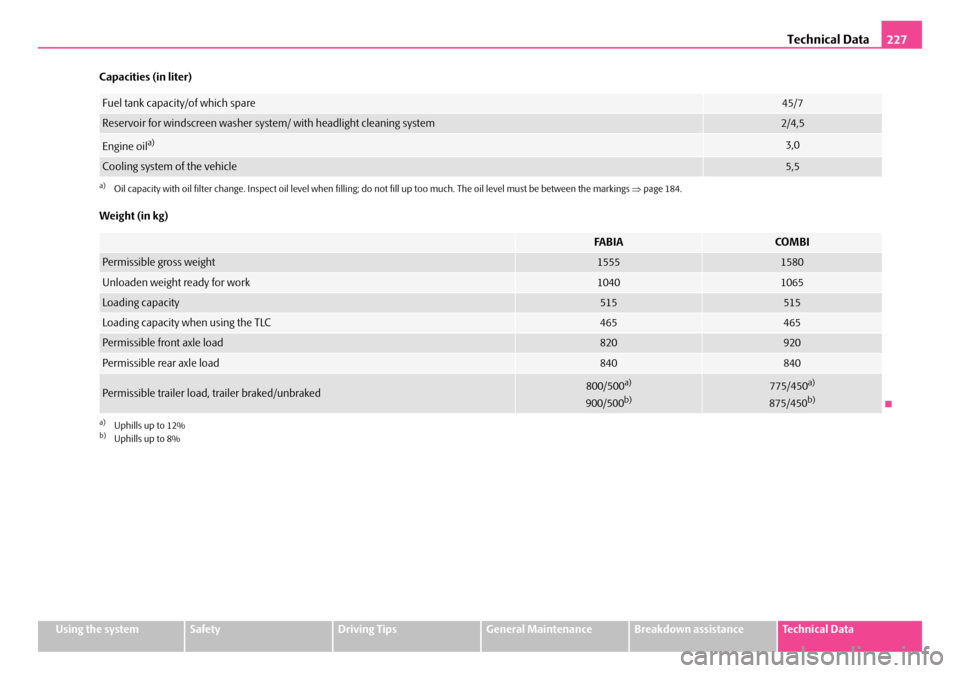
Technical Data227
Using the systemSafetyDriving TipsGeneral MaintenanceBreakdown assistanceTechnical Data
Capacities (in liter)
Weight (in kg)
Fuel tank capacity/of which spare45/7
Reservoir for windscreen washer system/ with headlight cleaning system2/4,5
Engine oila)
a)Oil capacity with oil filter change. Inspect oil level when filling; do not fill up too much. The oil level must be between the markings ⇒page 184.
3,0
Cooling system of the vehicle5,5
FA B I ACOMBI
Permissible gross weight15551580
Unloaden weight ready for work10401065
Loading capacity515515
Loading capacity when using the TLC465465
Permissible front axle load820920
Permissible rear axle load840840
Permissible trailer load, trailer braked/unbraked800/500a)
900/500b)
a)Uphills up to 12%b)Uphills up to 8%
775/450a)
875/450b)
NKO A05F 20.book Page 227 Wednesday, April 2, 2008 1:02 PM
Page 229 of 252

Technical Data228
1.2 l/51 kW - EU 4/EU 2DDK
Engine
Performances
Fuel consumption (in ltr./100 km) and CO2 emission (in g/km)
Power outputkW per rpm51/5400
Maximum torqueNm per rpm112/3000
Number of cylinders/Displacement (cm3)3/1198
Fuel - unleaded petrol min. RON95
FA B I ACOMBI
Maximum speedkm/h163164
Acceleration 0 - 100 km/hs14,915,1
Urban7,7
Non-urban4,9
Combination5,9
CO2 emission - combination140
NKO A05F 20.book Page 228 Wednesday, April 2, 2008 1:02 PM
Page 230 of 252
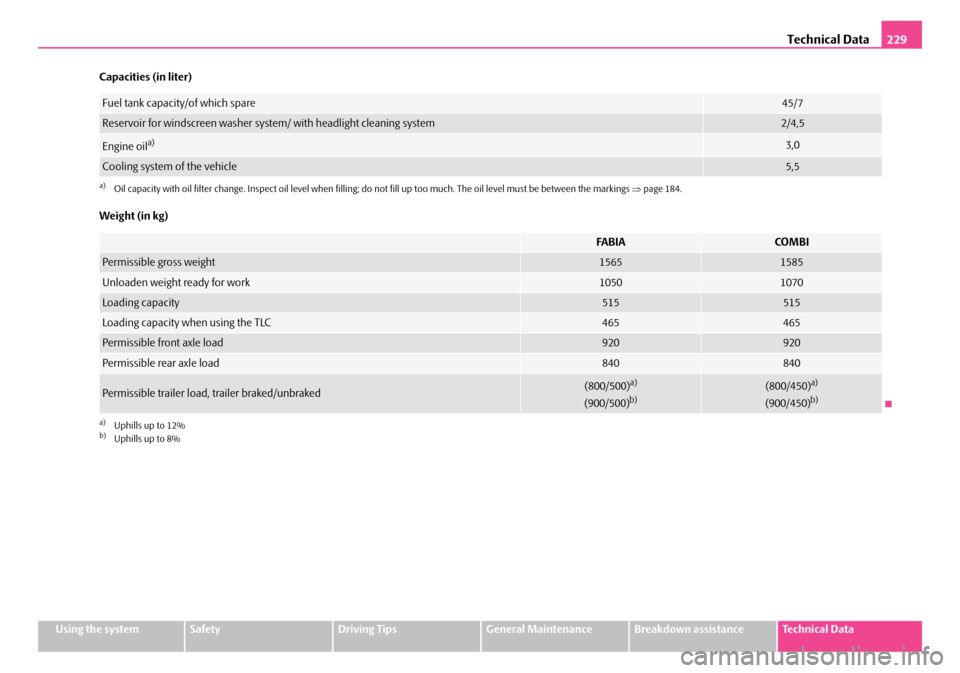
Technical Data229
Using the systemSafetyDriving TipsGeneral MaintenanceBreakdown assistanceTechnical Data
Capacities (in liter)
Weight (in kg)
Fuel tank capacity/of which spare45/7
Reservoir for windscreen washer system/ with headlight cleaning system2/4,5
Engine oila)
a)Oil capacity with oil filter change. Inspect oil level when filling; do not fill up too much. The oil level must be between the markings ⇒page 184.
3,0
Cooling system of the vehicle5,5
FA B I ACOMBI
Permissible gross weight15651585
Unloaden weight ready for work10501070
Loading capacity515515
Loading capacity when using the TLC465465
Permissible front axle load920920
Permissible rear axle load840840
Permissible trailer load, trailer braked/unbraked(800/500)a)
(900/500)b)
a)Uphills up to 12%b)Uphills up to 8%
(800/450)a)
(900/450)b)
NKO A05F 20.book Page 229 Wednesday, April 2, 2008 1:02 PM
Page 231 of 252

Technical Data230
1,4 l/63 kW - EU 4/EU 2DDK
Engine
Performances
Fuel consumption (in ltr./100 km) and CO2 emission (in g/km)
Power outputkW per rpm63/5000
Maximum torqueNm per rpm132/3800
Number of cylinders/Displacement (cm3)4/1390
Fuel - unleaded petrol min. RON95
FA B I ACO M B I
Maximum speedkm/h174175
Acceleration 0 - 100 km/hs12,312,7
Urban8,6
Non-urban5,3
Combination6,5
CO2 emission - combination155
NKO A05F 20.book Page 230 Wednesday, April 2, 2008 1:02 PM